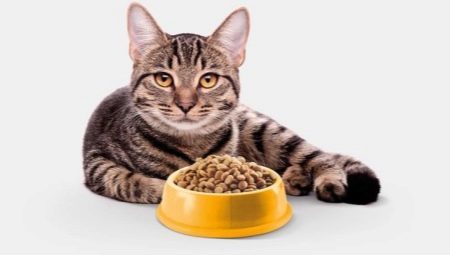Many veterinarians recommend that cat owners transfer their pets to grain-free feeds. Special series are developed by leading pet food manufacturers, taking into account the age, breed and needs of furry pets. It is believed that the absence of grain in the composition of components brings the diet closer to natural, with the right choice it helps to avoid allergies and obesity.
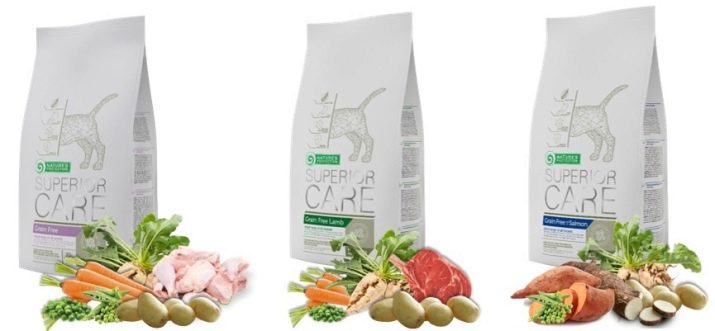
What is the difference between grainless feed and usual?
When developing a daily “menu” for cats, it is important to consider the needs of the animal. For the full work of the internal organs, a large amount of protein, vitamins and minerals is necessary. But more and more often, overweight pets with problems with hair, urinary system get into veterinary clinics. In most cases, it is improper feeding that causes such serious diseases.
Most feeds contain dietary fiber based on corn, wheat, soybeans, and rice, which act as ballast substances and help saturate the animal. But they contain a minimum amount of vitamins and a large percentage of carbohydrates that make you gain weight. In grain-free feeds they are replaced with useful components:
- sweet potato;
- potatoes;
- legumes;
- pulp of sugar beets.
More expensive series contain particles of carrots, pumpkins, tomatoes and even cranberries. This provides the cat's body with vitamins A, E, group B, antioxidants and phytoncides.

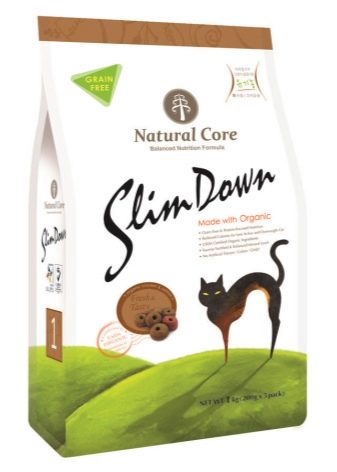
The addition of cereal components helps manufacturers significantly reduce the cost of the product, but such nutrition negatively affects the health of the pet.
Benefits
Grainless cat food has a number of benefits. which help improve the well-being and appearance of the pet.
- They do not contain gluten, so they do not provoke an allergic reaction. Gluten-free foods benefit from normal digestion and improved intestinal motility. Domestic cats often suffer from constipation due to low mobility, so the addition of healthy fiber reduces the risk of discomfort, reduces the frequency of regurgitation.
- It can act as a therapeutic food for obesity. A high protein content and a minimum of carbohydrates gives energy, preventing the animal from gaining weight while maintaining the volume of the portion. In premium feed with beef or chicken, the percentage of the protein component increases to 75–80%.
- Veterinarians note that plaque less often accumulates on the teeth of pets, tartar does not remain.
Food for cats without adding grain in some situations can be considered healing. Such food reduces the risk of urolithiasis, gives energy. The presence of nutrients makes the coat more smooth and shiny, normalizes the balance of the skin.
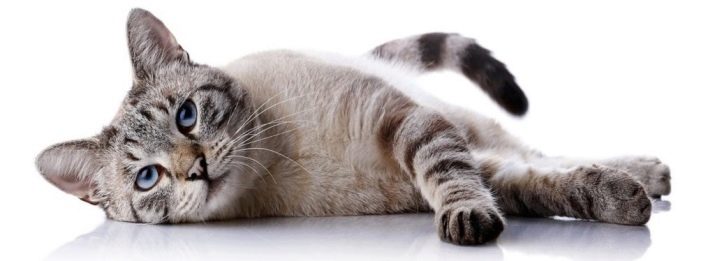
Types and classes of feed
On sale you can find two types of food for cats.
- Wet. 70% of it consists of liquid, contains broth or water. It is suitable for feeding kittens, weakened and old animals. The soft structure and balanced formulation make them the basis for a daily diet.
- Dry. Granular feed has a convenient shape, does not deteriorate during prolonged storage. Hard pieces cleanse teeth when eaten and bitten.
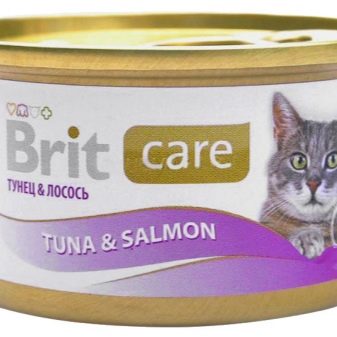
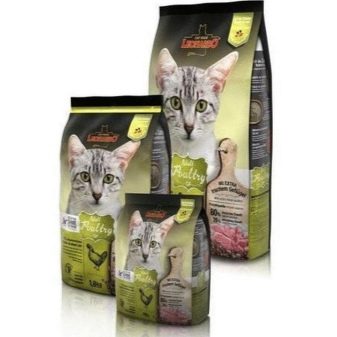
Most owners prefer dry food. They can be left in a bowl for a long time without fear of poisoning. But quality and the percentage of useful components, proteins, mineral compounds and ballast fibers are important. Therefore, they are divided into classes.
- Economy It has a low protein content of 15–20%. This is not enough for the full development of the cat, and prolonged feeding often leads to the development of diseases of the kidneys, pancreas.
- Premium class. Feed is the golden mean, combining quality composition and affordable price. The recipe contains natural poultry fiber, fish protein (up to 30–35%).
- Super premium. Do not contain harmful substances, salts or preservatives, not diluted with flavorings. This is the best animal feed of any age, providing excellent condition of the skin, coat.
Some manufacturers offer special holistic class feed.
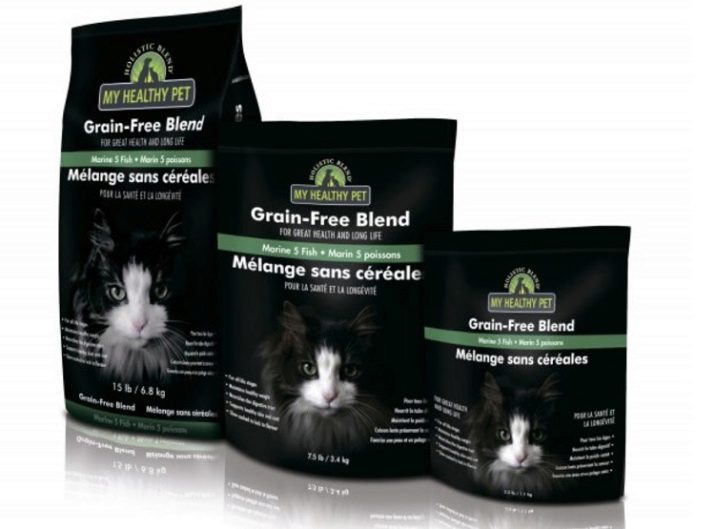
They differ in almost natural composition, do not contain chemical and synthetic compounds that can cause digestive upset or allergies in cats. The basis is meat of good quality, and only 10-15% of the volume is allocated to plant components.
Best Grainless Cat Food
When choosing a brand, it is better to forget about advertising and carefully study the reviews of experienced cat owners. Before buying, you can analyze the composition on the package, consult a veterinarian: some manufacturers offer special food for a kitten, with urolithiasis, to improve the quality of the coat.
There is a certain rating of grain-free feeds, which includes different brands.
- Natural balance. It differs in its natural contents and a large number of vitamins. Recommended for cats with health problems, prone to allergies to gluten or other substances.
- Halo Spot's Stew. This is a special line of the brand, which is developed on the basis of quality raw materials. It differs in the content of essential amino acids and vitamins. Recommended for active young animals.
- Blue Buffalo The company produces unique dry and wet foods saturated with extracts of alfalfa, flaxseed, and barley. Parsley, blueberries, and seaweed are added to some foods.
- Orijen. The manufacturer specializes in the production of grain-free feed.They are notable for their high cost due to the addition of fruit fibers, various herbs, and the absence of offal.
- Life's Abundance. At the heart of the preparation is a unique technology of roasting meat composition. With this method, all useful substances, minerals and vitamins are stored. As a protein, fish of the catfish family and chicken are used.


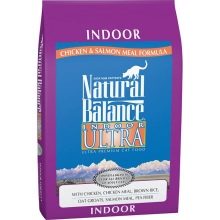
The list may replenish the brands Wellness Core, Farmina, Leonardo Grain-Free, PP Hills. Grain-free food is rarely found in stores, it is offered through official representatives. The price is consistent with quality, so the demand for such series is low. But more and more owners are trying not to save on pet health by choosing new brands.
Side effect of grain-free feed
When transferring a cat to a new diet, the animal may refuse to eat: premium foods often do not contain flavor enhancers and flavorings, so they are not so attractive to mustachioed pets. Good gluten-free series in composition are adapted to the nutrition of a cat living in natural conditions.
Veterinarians recommend switching to grain-free food in the following situations:
- hair loss, loss of gloss or smoothness;
- dandruff;
- increased lacrimation, sneezing;
- shortage of mass.
It should be understood that with a sedentary lifestyle and a calm nature of the cat, the use of grain-free food can be harmful to health. From an excess of protein, he begins to actively gain weight. It is not recommended for pets with diseases of the kidneys, genitourinary system. This threatens the formation of stones, blockage of the ducts. therefore it is better to coordinate the transfer to a new type of food with the veterinarian, and conduct a series of tests on the level of salts in the urine.
See below for an overview of dry cat food for the Grain Holistic class.
